NGC 3184
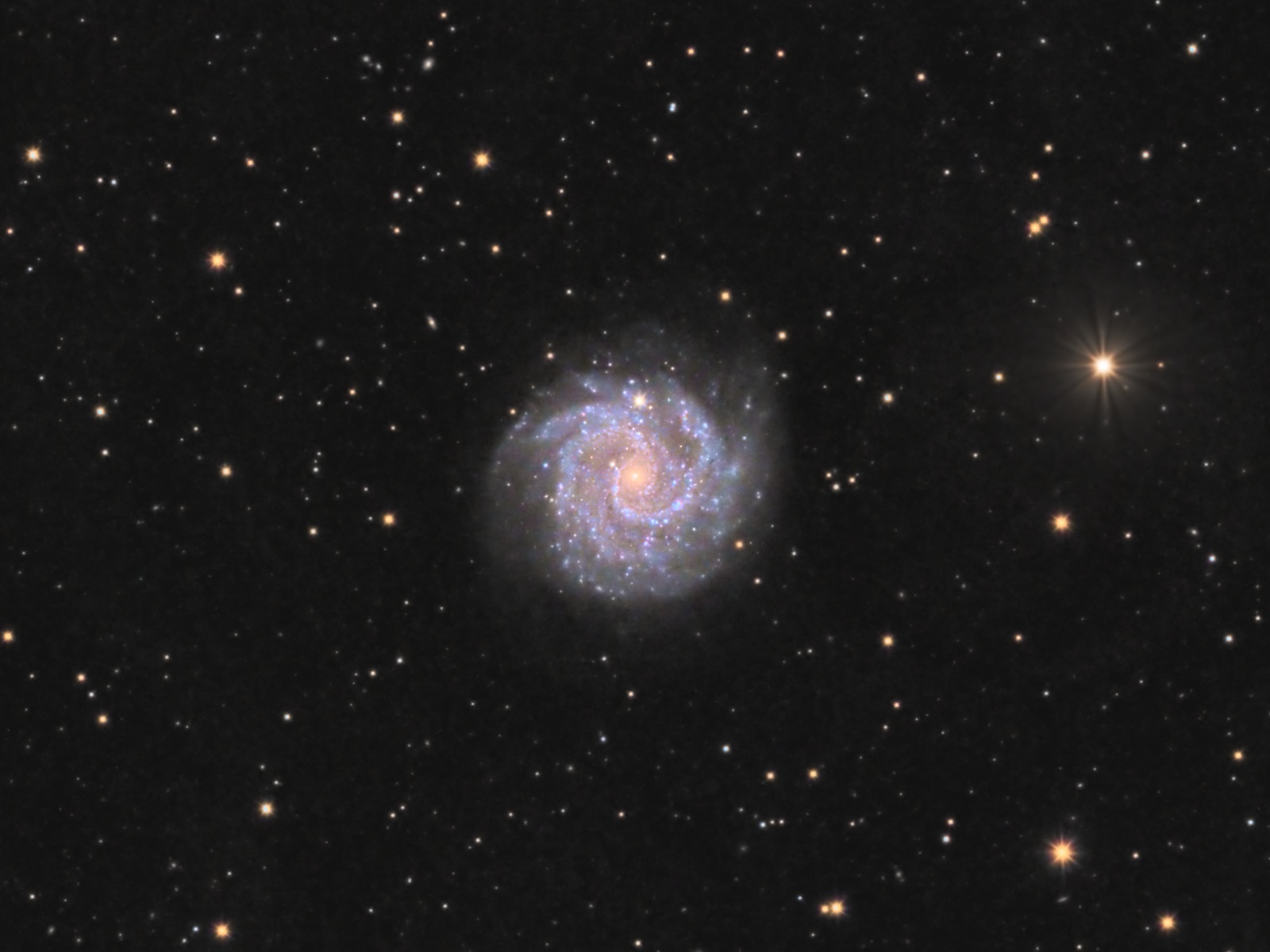 Click image for full size version
Click image for full size version
January 9, 2022, Featured in Astronomy Now! April 2022
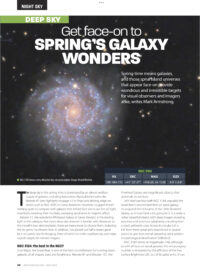 NGC 3184 is a nearly face-on barred spiral galaxy in Ursa Major, the Big Bear. Although it is a relatively small target for my focal length (1070 mm), it displays some nice detail and colour. NGC 3184 lies about 40 million light years away. Based on this distance and its apparent size, it is about 80,000 light years across. I’ve seen it referred to as “the Little Pinwheel,” being compared, I guess, to M101. NGC 3184y is unusual in that it has a high metal content (astronomer consider anything heavier than helium to be a “metal”).
NGC 3184 is a nearly face-on barred spiral galaxy in Ursa Major, the Big Bear. Although it is a relatively small target for my focal length (1070 mm), it displays some nice detail and colour. NGC 3184 lies about 40 million light years away. Based on this distance and its apparent size, it is about 80,000 light years across. I’ve seen it referred to as “the Little Pinwheel,” being compared, I guess, to M101. NGC 3184y is unusual in that it has a high metal content (astronomer consider anything heavier than helium to be a “metal”).
Tekkies:
Acquisition, focusing, and control of Paramount MX mount with N.I.N.A., TheSkyX and PHD2. Focus with Optec DirectSync motor and controller. Equipment control with PrimaLuce Labs Eagle 4 Pro computer. All pre-processing and processing in PixInsight. Acquired from my SkyShed in Guelph. Above-average transparency and seeing. Data acquired January 3-8, 2022 in a moonless sky.
Sky-Watcher Esprit 150 f/7 refractor and QHY600M camera with Optolong LRGB filters.
5 x 10m R, G, and B = 2hr30m
Total: 8hr30m
Data Reduction and Initial Processing
Preprocessing: The WeightedBatchPreProcessing script was used to create master frames for each filter. ChannelCombination was used to combine the R, G, and B masters. The RGB (for colour) and Luminance (for lightness) masters were cropped identically using DynamicCrop.
Gradient Removal: DBE was applied to both masters using Subtraction.
Colour
Colour Balancing: Colour of the RGB image was balanced with PhotometricColorCalibration.
Linear Noise Reduction: MultiscaleLinearTransform was used to reduce noise in the background areas, using an internal mask to protect bright structures. Layer settings for threshold and strength: Layer 1: 5.0 0.95, 2 iterations; Layer 2: 4.0, 0.85, 2 iterations, Layer 3: 3.5 0.75, 1 iteration; Layer 4: 2.0, 0.5, 1 iteration.
Stretching: HistogramTransformation was applied to make a pleasing, bright image, with background set to an intensity of approximately 0.10.
Lightness
Deconvolution: A star mask was made from the Luminance master to use as a Local Deringing Support Image. A stretched copy of the Luminance master was used as a deconvolution mask. . Deconvolution was applied (30 iterations, regularized Richardson-Lucy, ParametricPSF mode with default settings; Global dark deringing = 0.02; Global bright deringing 0.0022).
Linear Noise Reduction: MultiscaleLinearTransform was used to reduce noise in the background areas, using an internal mask to protect bright stars and the brighter regions of the galaxy. Layer settings for threshold and strength: Layer 1: 5.0 0.85, 1 iteration; Layer 2: 4.0, 0.75, 1 iteration, Layer 3: 3.3 0.65, 1 iteration; Layer 4: 1.0, 0.35, 1 iteration.
Stretching: HistogramTransformation was applied to make a pleasing, bright image, with background set to an intensity of approximately 0.10.
Combining Lightness and Colour Images
LRGB Combination: The lightness image was applied to the RGB image using LRGBCombination with default settings.
Additional Processing
Nonlinear Noise Reduction: TGVDenoise was used in L*a*b* mode to reduce noise with the image selected as the Local Support image (used like an external mask would be, to target the background areas and protect the stars and galaxy) (max. 1,000 iterations and convergence selected for both lightness and chrominance).
Contrast Enhancement: LocalHistogramEqualization was applied three times using an inverted star mask to protect the stars, with scales of 40, 90 and 150 (max contrast 1.5, strength 0.18, 1 iteration).
Sharpening: MultiscaleMedianTransform was used to sharpen Layers 2 – 4 with strengths of 0.2, 0.1, and 0.05, respectively, through a mask. Noise reduction was turned on with default settings for Layer 1. The mask was made by subtracting a star mask from a galaxy mask made using the GAME script.
Final Steps: Background, galaxy and star brightness, contrast, and colour saturation were adjusted in several iterations using CurvesTransformation with masks as required. Slight mottling in the background was reduced using PixelMath to brighten the darkest pixels. ICCProfileTransformation (sRGB IEC61966-2.1; Relative Colorimetric with black point compensation) was applied prior to saving in jpg format.


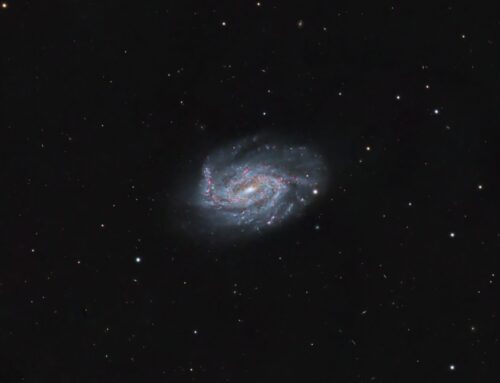
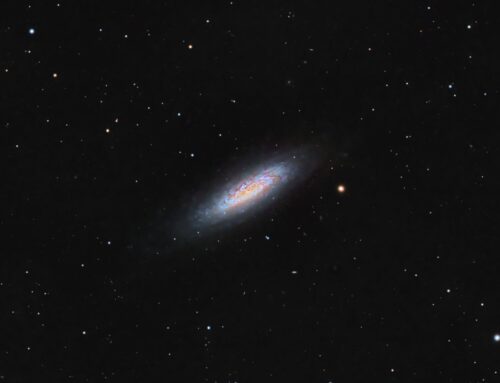
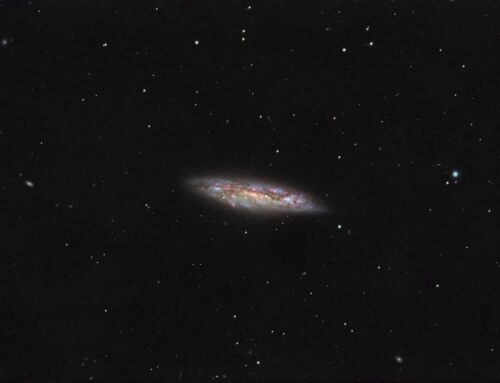
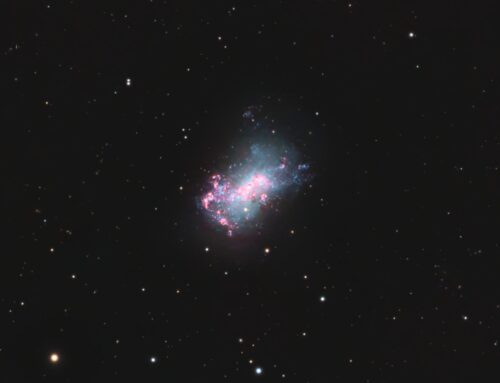
Leave A Comment